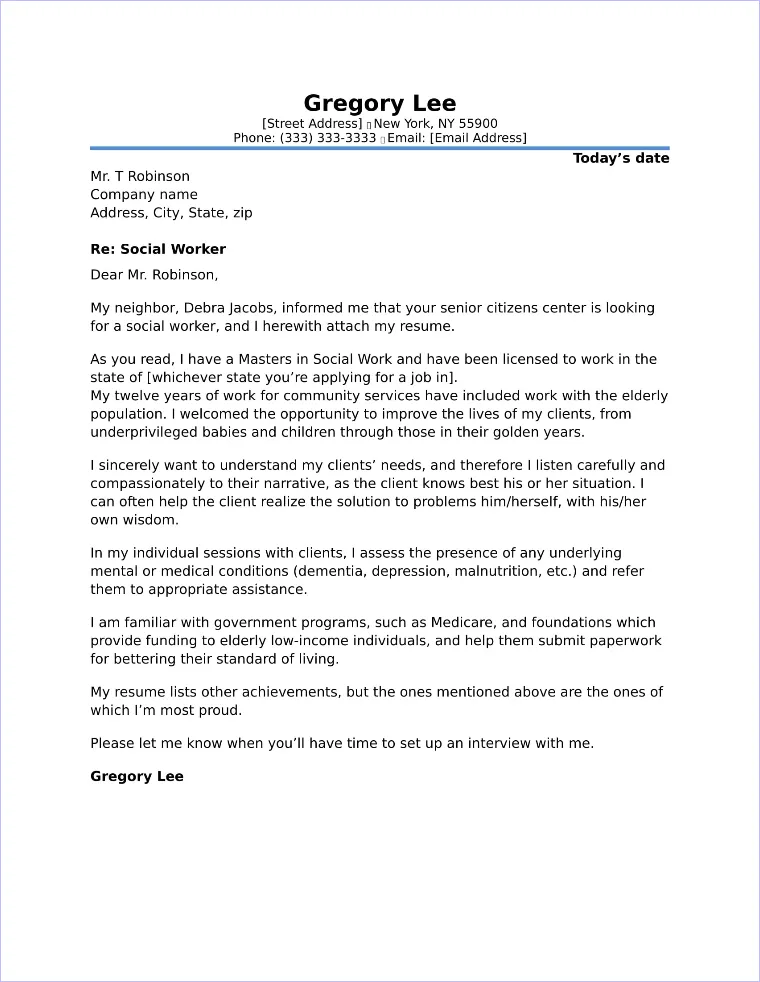What is a Social Services Cover Letter
A social services cover letter is a crucial document that accompanies your resume when applying for jobs in the social work field. It serves as your introduction to a potential employer and offers you the opportunity to elaborate on your qualifications, skills, and experiences. Unlike a resume, which provides a factual overview of your background, a cover letter allows you to showcase your personality, demonstrate your passion for social services, and explain why you are the ideal candidate for the specific position. It’s your chance to make a strong first impression and persuade the hiring manager to read your resume and consider you for an interview.
Purpose of a Cover Letter
The primary purpose of a social services cover letter is to articulate your interest in the position and the organization, highlighting your relevant skills and experiences. It provides context to your resume, allowing you to explain how your background aligns with the job requirements. The cover letter is your opportunity to demonstrate your understanding of the role, showcase your passion for helping others, and convey your enthusiasm for the organization’s mission. It’s a chance to stand out from other applicants and make a compelling case for why you deserve an interview.
Why a Cover Letter Matters
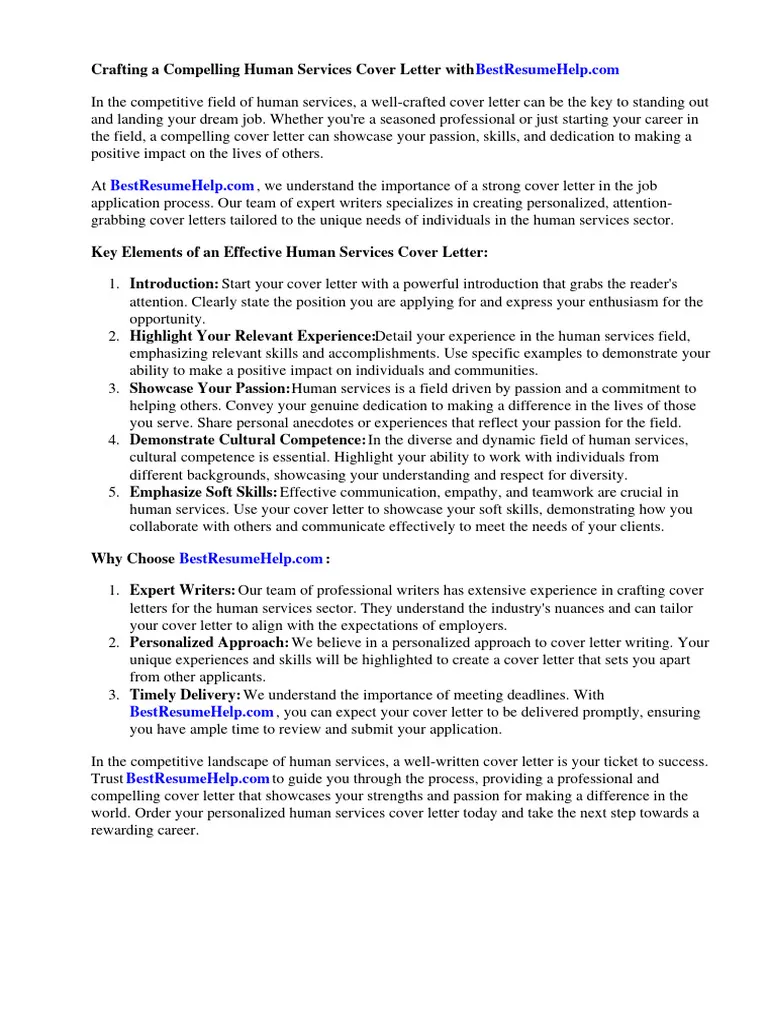
In the competitive field of social services, a well-crafted cover letter can significantly increase your chances of landing an interview. It allows you to personalize your application and demonstrate your unique qualifications. It shows the hiring manager that you have taken the time to learn about the organization and the specific requirements of the position. A strong cover letter can differentiate you from other candidates, especially if you have limited experience or are changing careers. It’s an essential tool for making a positive first impression and securing the opportunity to discuss your qualifications further.
Key Components of a Social Services Cover Letter
A well-structured social services cover letter consists of several key components that work together to present a compelling case for your candidacy. These components include the header, a professional greeting, a series of body paragraphs highlighting your skills and experience, and a strong closing. Each section plays a vital role in conveying your qualifications, passion, and suitability for the position. Careful attention to detail and a clear, concise writing style are essential for making a positive impact on the hiring manager. You must show why you are the perfect fit!
Header Information
The header of your cover letter should contain your contact information and the date. This information ensures that the hiring manager can easily reach you and keeps the letter organized. It should be clearly formatted and easy to read, using a professional font and standard spacing. The header sets the tone for the rest of the letter and provides essential information for the recipient. A well-formatted header is a sign of professionalism and attention to detail.
Applicant Contact Information
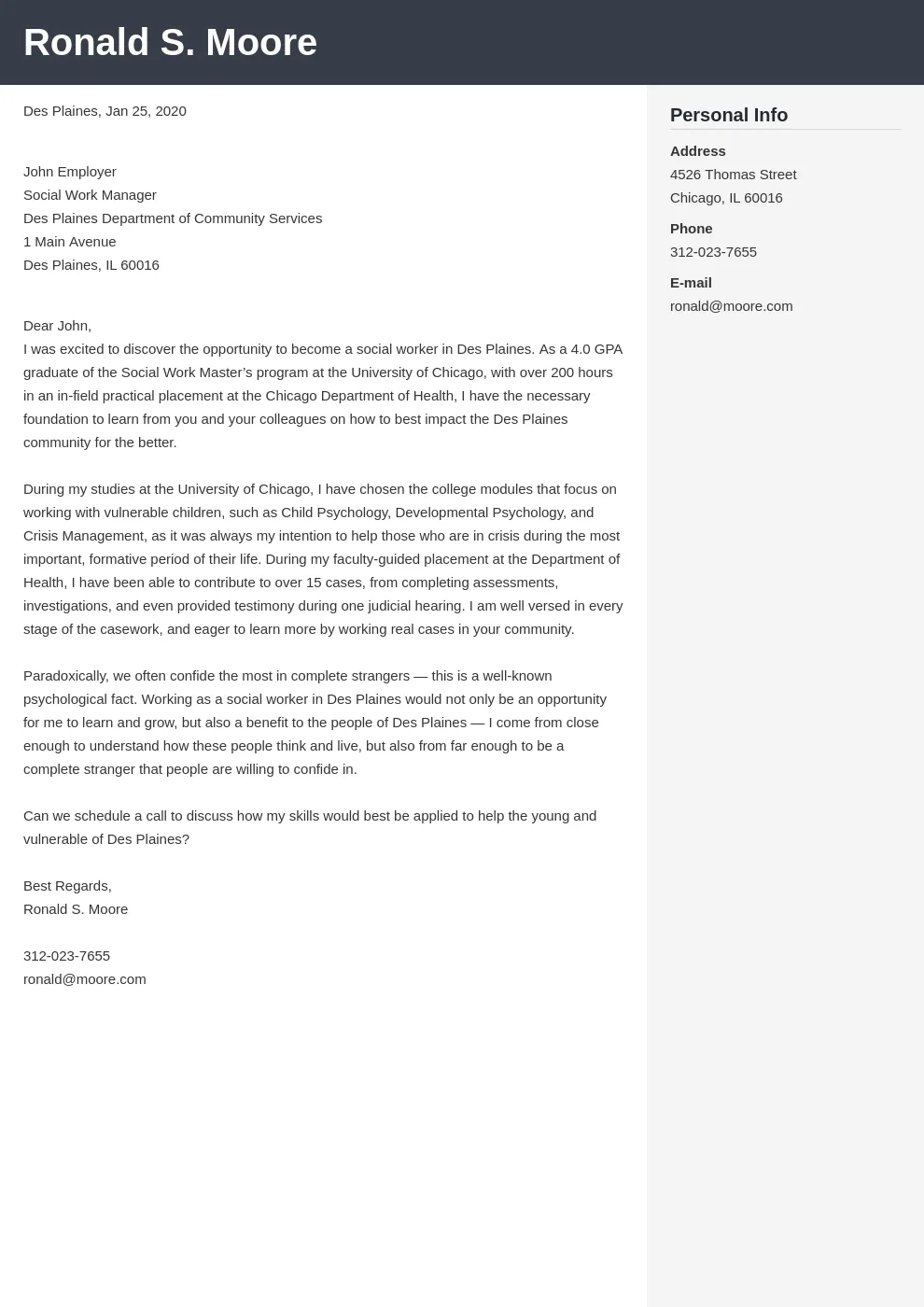
Include your full name, phone number, email address, and optionally your LinkedIn profile URL in the header. Make sure the contact information is accurate and up-to-date, as this is how the hiring manager will reach you. Use a professional-sounding email address. Ensure your voicemail greeting is also professional and reflects positively on you. This is the first interaction you have with the potential employer.
Date
Below your contact information, include the date you are sending the cover letter. The date helps the hiring manager keep track of when the application was received. It also shows that the letter is current and relevant. Formatting the date consistently with other elements of the letter demonstrates professionalism.
Hiring Manager Contact Information
If possible, address your cover letter to a specific person, such as the hiring manager or the director of the department. Research the company website or use LinkedIn to find the name and title of the appropriate contact person. Addressing the letter to a specific individual shows that you have taken the initiative to research the organization and are genuinely interested in the position. If you cannot find a specific name, you can use a general greeting.
Professional Greeting
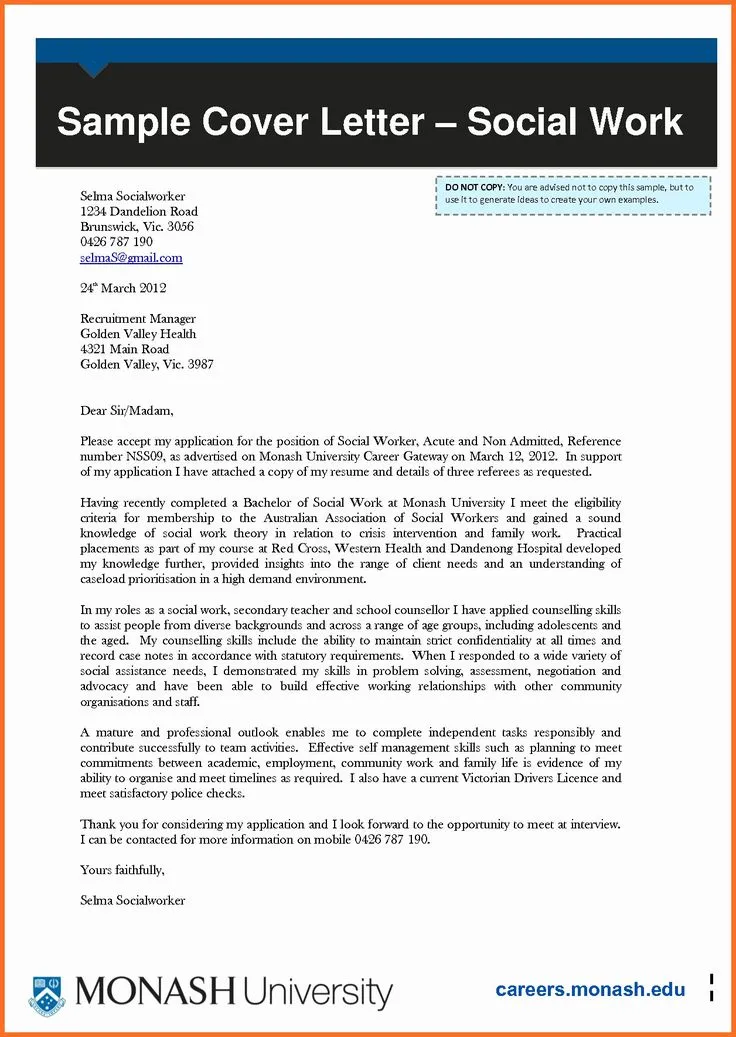
Start your cover letter with a professional greeting. If you know the hiring manager’s name, use ‘Dear Mr./Ms./Mx. [Last Name]’. If you don’t know the name, use a general greeting such as ‘Dear Hiring Manager’ or ‘To Whom It May Concern.’ Avoid overly casual greetings like ‘Hi’ or ‘Hello.’ The greeting sets the tone for the letter, so it is important to maintain a professional and respectful tone throughout your entire cover letter.
Body Paragraphs
The body paragraphs are the heart of your social services cover letter. This is where you demonstrate your qualifications, skills, and passion for the position. Use clear, concise language and provide specific examples to support your claims. Each paragraph should focus on a specific aspect of your qualifications, such as your experience, skills, or understanding of the organization’s mission. Use this area to truly sell yourself. Organize your thoughts logically, making sure it flows well.
Opening Paragraph
Start your opening paragraph by stating the position you are applying for and where you saw the job posting. Express your enthusiasm for the opportunity and briefly explain why you are interested in the organization. Make a strong statement that immediately captures the hiring manager’s attention. This is your chance to grab the readers attention. The goal of the opening paragraph is to get the hiring manager to read the rest of your letter.
Expressing Enthusiasm
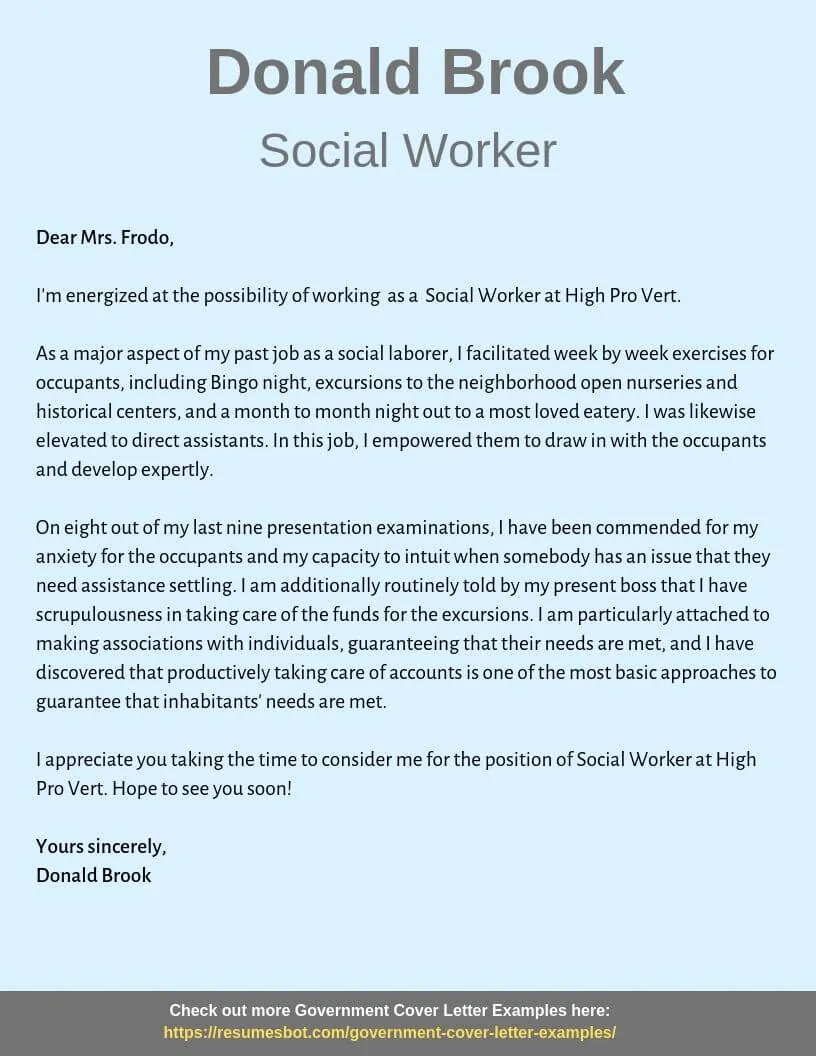
Show your excitement for the opportunity by stating your interest in the role. Mention what specifically attracts you to the position or the organization. Expressing genuine enthusiasm can make your cover letter more memorable and demonstrate your commitment to the role. Your passion will be obvious to the reader!
Stating the Position
Clearly state the position you are applying for. Include the job title and, if possible, the job posting number. This clarifies your intentions and helps the hiring manager quickly understand which position you are interested in. Make sure you have the proper job title!
Highlighting Relevant Skills and Experience
In the subsequent body paragraphs, highlight your relevant skills and experience. Choose the skills and experiences that align with the job requirements. Use specific examples from your previous roles or volunteer experiences to illustrate your qualifications. Quantify your achievements whenever possible to demonstrate your impact. Explain your previous job experiences that align with the current job posting.
Quantifiable Achievements

When describing your achievements, use quantifiable data to demonstrate your impact. Instead of saying ‘I improved client outcomes,’ say ‘I increased client satisfaction scores by 15%.’ Quantifiable achievements provide concrete evidence of your skills and abilities. Use numbers to help you. Use words like ‘managed’, ‘implemented’, and ‘achieved’ to illustrate your impact.
Demonstrating a Passion for Social Services
Demonstrate your passion for social services by sharing your motivations for working in this field. Discuss your commitment to helping others and your understanding of the challenges faced by vulnerable populations. Show your genuine interest in making a positive impact on the community. You can also discuss values that align with the organization’s mission and vision.
Closing Paragraph
In your closing paragraph, summarize your qualifications and reiterate your interest in the position. Express your gratitude for the hiring manager’s time and consideration. Include a call to action, such as stating your availability for an interview. End the letter with a professional closing and your signature.
Call to Action
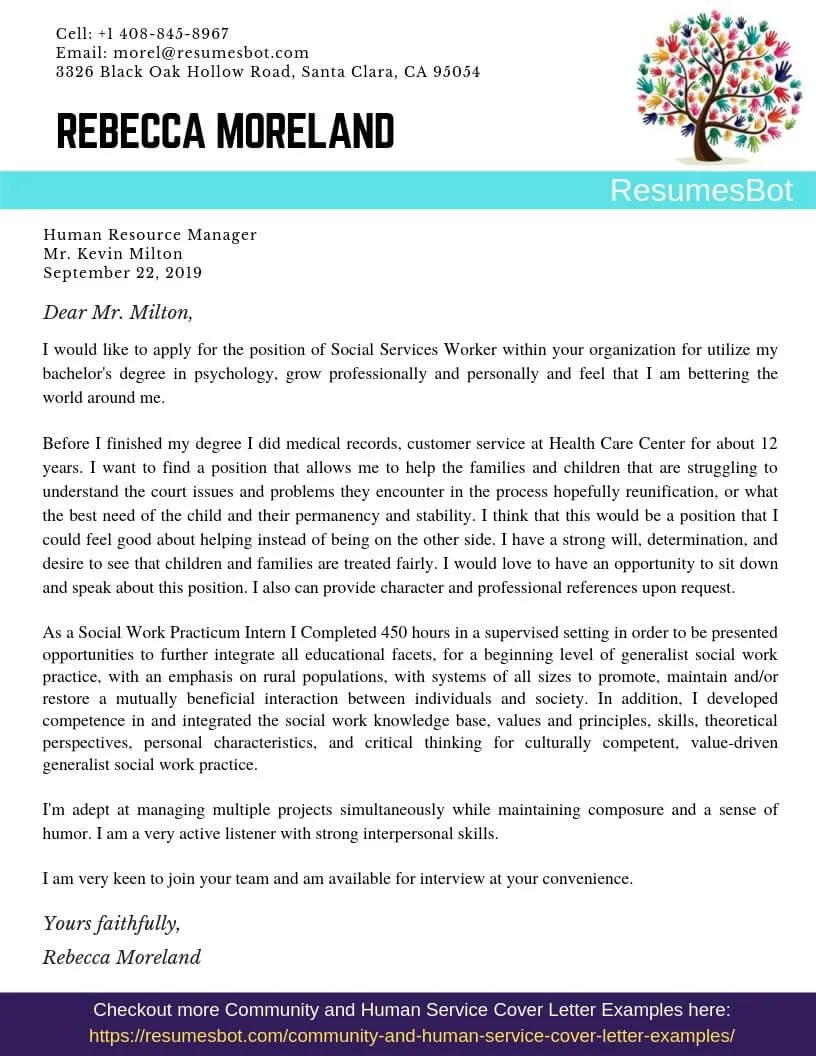
Conclude your cover letter with a clear call to action. State that you are eager to discuss your qualifications further and welcome the opportunity for an interview. Make it easy for the hiring manager to move forward with your application. Be direct, and express your readiness to move to the next stage of the application process.
Formal Closing and Signature
End your cover letter with a formal closing, such as ‘Sincerely,’ ‘Best regards,’ or ‘Yours sincerely.’ Leave space for your handwritten signature above your typed name. A formal closing shows professionalism and respect for the hiring manager.
Formatting and Style Guide
Proper formatting and style are essential for a polished and professional cover letter. Use a clear and easy-to-read font, standard margins, and appropriate spacing. Ensure that your letter is free of errors and easy to navigate. These details demonstrate your attention to detail, which is a crucial skill in the social services field.
Font and Font Size
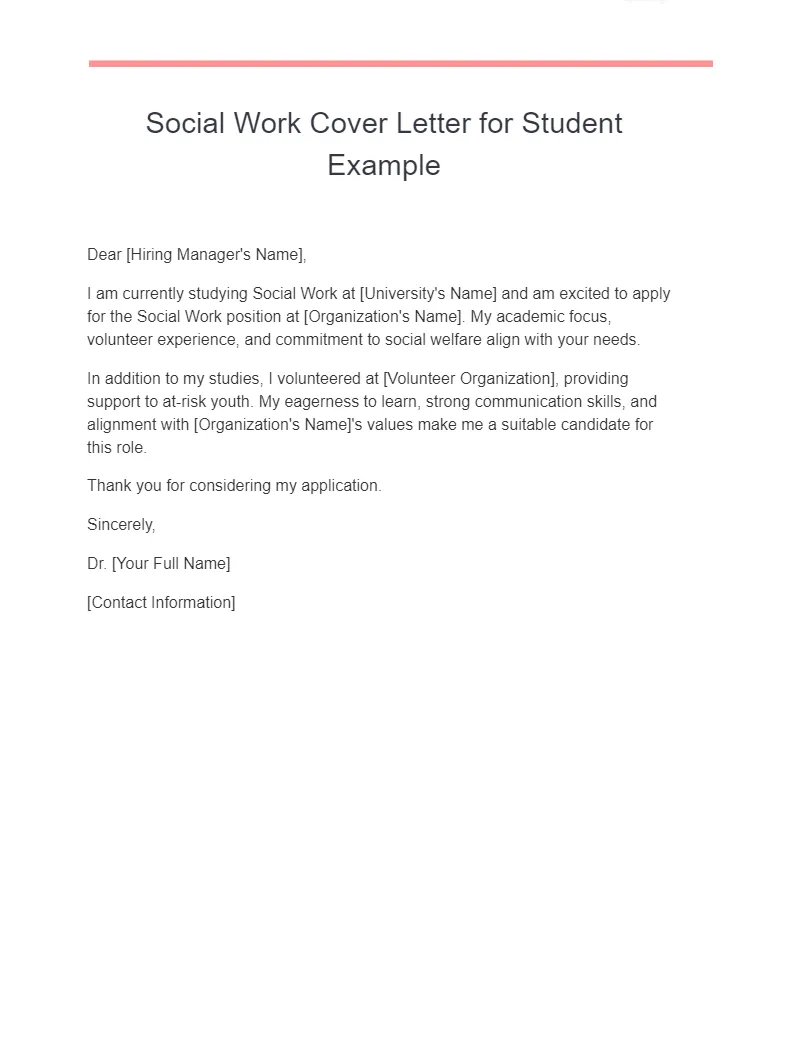
Choose a professional font, such as Times New Roman, Arial, or Calibri. The font size should be between 10 and 12 points. A readable font and appropriate size make your cover letter easy to read. Always use professional fonts.
Margins and Spacing
Set your margins to 1 inch on all sides. Use single-spaced lines within paragraphs and double-space between paragraphs. Proper margins and spacing make your cover letter visually appealing and easy to read.
Proofreading and Editing
Proofreading and editing are crucial steps in the cover letter writing process. Before submitting your cover letter, carefully review it for any typos, grammatical errors, or inconsistencies. Ask a friend or colleague to read it over and provide feedback. A polished cover letter shows your attention to detail and your commitment to excellence.
Common Mistakes to Avoid
Avoid common mistakes that can hurt your chances of getting an interview. Length, generic content, and errors can quickly lead to your application being rejected. Being aware of these pitfalls will help you to create a strong and effective cover letter.
Length and Brevity
Keep your cover letter concise and to the point. Aim for a length of one page. Avoid including unnecessary details or rambling. Hiring managers are busy, so make sure your cover letter is easy to read and highlights the most important information. Use the one page to give them the information needed to make the decision to read your resume.
Generic Content
Avoid using generic content or templates. Customize your cover letter for each job application. Show the hiring manager that you have taken the time to learn about the organization and the specific requirements of the position. Generic cover letters make it look like you are not taking the time to make the effort.
Typos and Grammatical Errors
Always proofread your cover letter carefully for any typos or grammatical errors. These errors can damage your credibility and make a negative impression on the hiring manager. Get a second pair of eyes to review your letter before submitting it. Typos and grammar are a sign that you might not be detail-oriented.
Social Services Cover Letter Examples
Reviewing social services cover letter examples can provide valuable insights into best practices. Look at successful cover letters for inspiration and guidance. Pay attention to the language, tone, and structure used in the examples. However, remember to customize your cover letter to reflect your unique skills and experiences. You can also get help from the internet. There are plenty of free examples.
Tailoring Your Cover Letter
Tailoring your cover letter to each job application is essential. Research the organization and the specific requirements of the position. Highlight the skills and experiences that align with the job description. By customizing your cover letter, you show the hiring manager that you are genuinely interested in the position and understand the organization’s needs. This gives the hiring manager the reason to chose you!
Researching the Organization
Before writing your cover letter, research the organization. Visit their website, read their mission statement, and learn about their values and programs. Demonstrate your knowledge of the organization in your cover letter. This shows that you are truly interested in working there and that you are a good fit for their culture.
Matching Skills to Job Requirements
Carefully review the job description and identify the required skills and qualifications. Match your skills and experiences to the job requirements in your cover letter. Provide specific examples of how you have demonstrated these skills in the past. Use your cover letter as a bridge to tell the hiring manager how you have the proper skillset.
Keywords from Job Description
Incorporate keywords from the job description into your cover letter. This helps the hiring manager and applicant tracking systems (ATS) identify your application as a good match for the position. Use keywords naturally throughout your cover letter. Do not over use them and make it look like it is keyword stuffing. This can get your resume thrown out automatically.
Tips for Success
Here are some additional tips to help you write a successful social services cover letter. These tips cover how to showcase your achievements, use action verbs, and highlight any certifications or licensures. Implementing these tips will greatly increase your chances of getting noticed and receiving an interview.
Showcase your achievements
Instead of simply listing your responsibilities, focus on your achievements. Quantify your achievements whenever possible. Provide concrete examples of how you have made a positive impact in your previous roles. Use strong verbs to describe your accomplishments. Focus on how you can make the difference.
Use action verbs
Use strong action verbs to describe your skills and experiences. Action verbs make your cover letter more dynamic and engaging. Examples of effective action verbs include ‘managed,’ ‘implemented,’ ‘developed,’ ‘coordinated,’ ‘facilitated,’ and ‘achieved.’ Be sure to write them in the past tense. This will help the reader understand your contribution.
Highlight any certifications or licensures
If you have any relevant certifications or licenses, be sure to highlight them in your cover letter. Include the name of the certification or license, the issuing organization, and the date of issue. Certifications and licenses demonstrate your commitment to professional development and your ability to meet the required standards of practice. Make sure to mention this in your cover letter.
